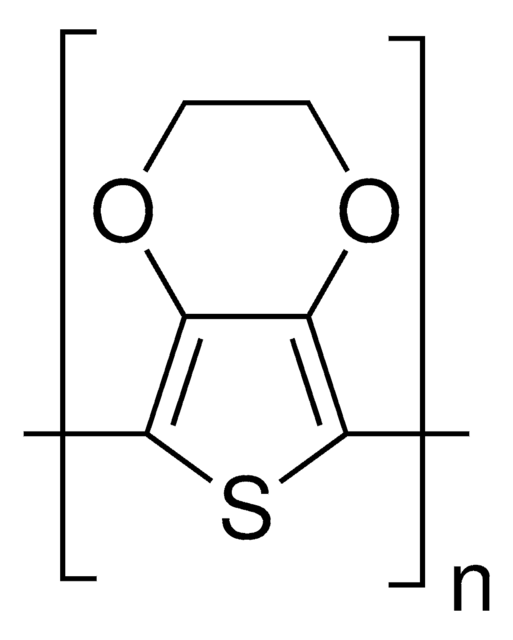推荐产品
产品名称
聚乙撑二氧噻吩-聚(苯乙烯磺酸盐), high-conductivity grade
等级
high-conductivity grade
质量水平
描述
Visual Light Transmission (VLT): ≥ 80%
表单
dispersion
环保替代产品特性
Design for Energy Efficiency
Learn more about the Principles of Green Chemistry.
sustainability
Greener Alternative Product
浓度
0.5-1 wt. % (PEDOT: PSS in water)
薄层电阻
<200 Ω/sq (coating : 40μ wet, drying: 6 min 130°C)
pH值(酸碱度)
2-3.5
粘度
≤70 mPa.s(20 °C)
环保替代产品分类
, Enabling
储存温度
2-8°C
SMILES字符串
CC1=C2OCCOC2=C(C)S1.CCC(C3=CC=CC=C3)C.C[SO3-]
一般描述
- 低带隙
- 良好的光学性能
- 高导电率
- 低氧化还原电位l
- 易于操作
- 可调成膜能力
应用
- ITO替代涂层。
- 不含ITO OPV。
- 90%VLT*(可见光透射)下的表面电阻(SER):125 Ω/平方。
- 稳定性比R/R_0(60℃,95%RH下500小时):1.3。
制备说明
- 如果需要,用DI水或相容溶剂稀释。
- 用电晕或血浆治疗预处理的底物会增加粘连。
其他说明
- 这些添加剂的水含量低(小于100 ppm)。
- 请在惰性和无湿气的环境(手套箱)下使用。
- 保持容器密闭。
- 远离热源和着火源。
- 存放在阴凉干燥处。
- 避免与氧化剂存放在一起。
法律信息
警示用语:
Warning
危险声明
危险分类
Eye Irrit. 2 - Skin Irrit. 2
储存分类代码
12 - Non Combustible Liquids
WGK
WGK 2
闪点(°F)
Not applicable
闪点(°C)
Not applicable
商品
A detailed article on conducting polymer materials for flexible organic photovoltaics (OPVs) applications.
Advancements in bioelectronics, incorporating self-healing materials for wearable devices, and measuring bioelectric signals to assess physiological parameters.
Progress in Organic Thermoelectric Materials & Devices including high ZT values of >0.2 at room temperature by p-type (PEDOT:PSS) & n-type (Poly[Kx(Ni-ett)]) materials are discussed.
To achieve net-zero emissions by 2050, renewable power contributions must triple. Photovoltaic stations provide vital utility power, achieved primarily through third- and fourth-generation technology. Promising trends include recycling and revolutionary, ultra-lightweight, flexible, and printable solar cells.
我们的科学家团队拥有各种研究领域经验,包括生命科学、材料科学、化学合成、色谱、分析及许多其他领域.
联系技术服务部门


